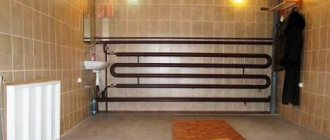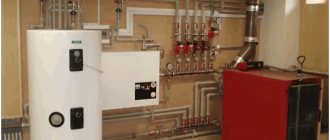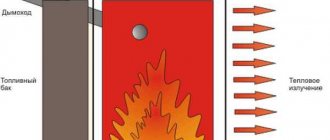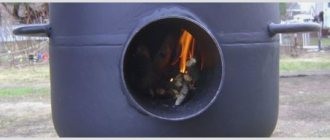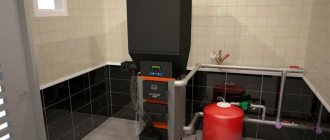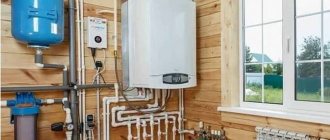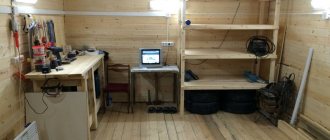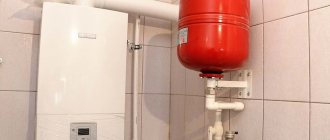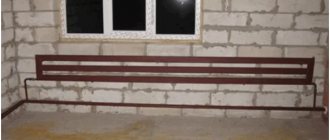Heating with electricity will not cost too much if you choose the right heating system and insulate the garage. Even the most economical electric boiler for heating a garage will “heat the street” if the walls, gates and roof are not insulated.
On the one hand, sudden temperature changes in winter accelerate metal corrosion. But, if you organize good ventilation in the garage, then in a warm room there is no need to warm up the engine, and there are no cold starts that are harmful to the engine.
Basic requirements for the heating system
First of all, you need to identify all the key requirements for heating in a garage. Let's list the main factors.
- It is important to make the heating system reliable, to ensure its resistance to sudden temperature fluctuations. Of course, most garages are not constantly heated. Consequently, the system will first heat up and then cool down greatly. These are significant additional loads.
- Please note that there is a high probability of frequent power outages. Here we are dealing not with a living space, but with a garage. And the electric heating system must be adapted to more difficult conditions.
- The optimal solution is to orient the heating system to operate in automatic mode. The automatic locking system must be activated in any emergency situation.
- Safety, especially in a garage, plays a huge role. In this room, fuels and lubricants, wheels and all kinds of spare parts and tire sets are stored. Of course, it is especially important to carefully follow fire safety rules.
- It is advisable to consider the efficiency of the heating system. Here you should try to maintain a balance of performance and cost so that heating is feasible from an economic point of view.
The heating boiler in the garage should work as efficiently as possible. To do this, it is imperative to minimize heat loss in the room. This is the only way to achieve better results. The building is well insulated and a sophisticated ventilation system is installed. It is also worth considering the optimal temperature for warming up the garage. In this room there is no need to achieve 18-20 degrees, as in a residential building. It is enough if the thermometer rises to 5-10 degrees Celsius.
Solid and liquid fuels and gas are used as fuel for boilers. You can install a water or electric heating system.
Safety precautions when heating a garage
Before you start heating your garage, you need to study safety precautions and adhere to them. Main criteria:
It is forbidden to heat a garage with gas equipment if explosive substances and mixtures are or will be stored in it. When entering a gas-heated room, you should sniff before turning on the heater. This method will help to avoid an explosion and notice a leak in time. It is necessary to think in advance about what technology is best to use to heat a car garage in winter even before it is built. If you decide to heat the building with electricity, then you need to install fuses
This is important because in the event of a power surge, the devices will continue to operate. You need to take into account the power of the electrical network. You cannot use equipment that is more powerful than the network itself. To ensure warmth in the garage, it is necessary to take care of ventilation and good thermal insulation in advance. When leaving, turn off electrical appliances. Install sensors that detect smoke. There should be a fire extinguisher in the garage.
Attention! Do not use heating equipment to dry clothes. Constantly need to monitor the condition of the devices
The choice of heating device depends only on the requirements of the car owner. But it’s better not to save on such equipment
You must constantly monitor the condition of the devices. The choice of heating device depends only on the requirements of the car owner. But it’s better not to save on such equipment.
Types of boilers
When organizing garage heating, it is possible to use the following types of heating boilers:
- A gas boiler. If it is possible to divert the pipe from the gas main, installing a boiler running on natural gas solves all problems. Gas as a fuel is considered one of the cheapest. Water heated by a boiler can be used as a coolant. Heating can be provided by convection using fans. When installing for heating gas installations, the following advantages can be highlighted: cheap energy resources, accessibility of highways, autonomous operation, increased energy efficiency, high reliability and durability. Modern gas boilers can operate from a gas central line or from liquefied gas cylinders. The disadvantages include the need for complex coordination and increased requirements for fire safety and the ventilation system.
- Electric boiler. The easiest way is to install a boiler in the garage, in which the coolant is heated by electricity. The operating principle of this equipment is based on heating water into heat exchangers using electric heating elements. Installations of this type are small in size and easy to operate. The main advantages are complete silent operation, automatic adjustment, and the absence of combustion products. The main disadvantage is the significant increase in the cost of electricity compared to natural gas. In addition, the heating system becomes completely dependent on uninterrupted power supply, which causes certain problems, for example, in rural areas.
Economical heating, fuel options
If you decide to make your garage heated, it is worth considering various solutions.
Elimination of heat loss
The first step to help get rid of the cold is to eliminate excessive drafts. It is advisable to use acrylic silicone or polystyrene foam for window frames, because the window is the source of valuable heat loss.
Owners of a metal garage have a little more concern, where the connections of structural elements are rarely precise. A sealed garage is not an absolute blessing. The point is the moisture present here in abundance. Lack of ventilation contributes to dampness and corrosion of the car’s sheet metal. It is necessary to maintain minimal ventilation by temporarily opening a window or door.
Electric garage heating
A common choice is portable heating. A popular inexpensive heating device is electric heaters. Electric heaters consist of a heater and an axial fan, which is responsible for the rapid distribution of heat in the room. Heaters for garage use typically have a metal body with a plastic handle for easy transportation. Small size and weight are the main advantages of electric heaters. When choosing a heater, you should find out whether it has adjustable power and a thermostat.
Heaters for technical premises around the house are distinguished by increased thermal power compared to their domestic counterparts. Small heaters convert 3-5 kW of electricity into heat, allowing you to effectively heat rooms of 20-25 square meters. Basic models of modern heaters can be purchased at an attractive price. Due to the high electrical current consumption, such heating is quite expensive.
Gas heating
The use of gas heat guns is more effective than electric heating. Gas fuel is supplied from a propane or propane-butane cylinder. Due to the high calorific value of raw materials and oxygen combustion, gas heaters achieve extremely high heat output - up to several tens of kilowatts.
Cheap gas heaters with a thermostat cost 1.5-2 times more than an electric heater.
Gas devices are designed for heating open spaces and rooms with good ventilation. They do not require chimneys; it is necessary to provide air flow to ensure combustion. Gas heaters are used for heating workshops and large garages and workshops, where energy-efficient devices are required to quickly achieve the desired temperature in a short period of time. Gas heaters are ideal for indoor plants - when they burn oxygen, they release carbon dioxide, which is necessary for photosynthesis. The device must be equipped with:
- electrovalve,
- flame control.
Waste oil furnace
If you have access to a large amount of waste, you can heat your garage using an oil furnace. This is a popular solution to the issue of cheap heating. The performance of waste oil furnaces is similar to that of gas heaters. The furnace can easily raise the temperature even in large workshops.
Cheap stoves can be bought for 25,000 rubles. It is worth considering choosing a stove with a closed combustion chamber and chimney. This is a convenient, safe solution.
Waste oil furnaces are the least mobile of all the devices considered due to their high weight. Luckily, many portable stoves are mounted on a mobile stand.
Video
Conclusion Many car owners wonder whether garage heating is necessary. It is not always necessary to heat a given room. In winter, it is still much warmer in the garage than outside, we will protect the car from ice and snow, and we will save time that you have to spend in the morning cleaning the car, warming up the engine, and the interior in severe frosts. Even in a detached garage, the temperature will only drop below freezing when the frost lasts for a while. Heating a garage requires insulating the walls, roof, windows, and gates.
To choose the right type of heating, it is important to correctly assess the expected intensity of use, the size of the room:
for periodic heating of the room, electrical equipment is recommended; in large rooms, workshops, auto repair shops, it is better to pay attention to gas and oil heaters
Fuel boilers
The options discussed above involve connecting the equipment to centralized gas or electrical networks. What to do in the absence of highways and unreliable power supply? A mini-boiler room in a garage can be based on boilers running on liquid or solid fuel, which do not depend on the supply of centralized energy. The following settings are distinguished:
- Solid fuel boilers. A modern boiler of this type can be safely installed even in a room such as a garage. The installations are distinguished by their versatility, i.e. they are able to work on coal, peat, firewood, even construction waste and straw. It is considered optimal to use special combustible briquettes based on compressed coal dust and other components. Fuel consumption occurs in a minimum amount, which is ensured by its complete combustion. The boilers operate on the pyrolysis principle, which gives a fairly high efficiency.
- Liquid fuel boilers. They lay down an important principle of economy. They can be operated on used engine oil. This makes it possible to obtain cheap fuel and at the same time solve the issue of waste disposal.
The main advantage of fuel boilers is the absence of the need to obtain permits and the availability of fuel. An important disadvantage is the presence of a significant amount of combustion products. To remove them, you need a reliable chimney, the pipe of which should go to the roof.
Conclusions and useful tips
From all of the above, as well as on the basis of practical observations, the following conclusions suggest themselves:
- Despite all the difficulties with burning solid fuels, firewood and other waste occupy a leading position among energy sources due to their reasonable price.
- For the same reason, most garages have air heating. It is simple to implement and allows you to quickly warm up the room.
- Air heating is made more effective by forced blowing of the heat source or pumping air through the heating chamber.
- Water heating is more appropriate in workshops and car services; for a private box the system is a bit expensive.
- Electric garage heating is an auxiliary or short-term option that is easy to implement, but difficult to pay for during operation.
Whatever method of garage heating you choose, the degree of insulation of the building will play a big role. An iron frame with slots in the gates does not retain heat at all and cannot be heated, so heating it is expensive and pointless. Another thing is that the walls are made of foam blocks or insulated on the outside with polystyrene foam; savings when heating such a garage are quite achievable.
Installation stages
To ensure safe operation of the boiler room in the garage, it is important to install a high-quality ventilation system that can remove all harmful gases from the room. To do this, you need to correctly assess the required fan performance. Its power can be calculated using the following formula: M = (SxHx12) + 30%, where M is the hood power; S is the area of the room; H is the height of the garage. In this case, the formula takes into account that complete renewal of the air volume must be ensured in 12 hours, and the minimum power reserve of the installation is estimated at 30%.
The design of the heating boiler can be single-circuit or double-circuit. In the first case, the coolant heated in the boiler is intended only for heating the room, and therefore circulates through a closed system with radiators. In the double-circuit version, an additional network is provided for obtaining hot water or removing coolant for heating another room, a house.
If the owner wishes, the boiler room in the garage can easily be installed with his own hands, but using standard equipment. When installing a gas boiler, the project must be agreed upon with the relevant authorities. The arrangement of the system must be carried out taking into account technical and fire safety requirements. After completing all these stages, you can use the installed equipment for many years and enjoy the unconditional comfort that it will give.
How to calculate the power of an electric boiler
Before buying a boiler, you need to calculate the required power.
The boiler power must take into account electricity limits. Due to the limitation of electricity supplied by local electrical networks, if consumption exceeds the circuit breaker, the circuit breaker is triggered, and the heating system of the house may be de-energized. Thus, when choosing a boiler power, you should be guided by calculations and not exceed it. A limitation may be the cross-sectional area of the supply electrical cable. When choosing a single-phase or three-phase boiler, it is necessary to check that the power of the equipment matches the cross-section of the installed cable. In addition, boilers with constant and variable (modulated) power are offered on the market. The former are more preferable because they cannot allow excess electricity consumption.
An approximate calculation of power takes into account the area of all heated rooms in the house and is done according to the formula: M = P x Where. / 10m2
where M is the power of the electric boiler (kW);
P – area of heated premises;
Where. – specific boiler power, depending on the region:
- for cold climates Kud. 1.2 – 2.0
- for moderate 1.0 - 1.3
- for southern regions 0.7 – 0.9
How to calculate the power of an electric boiler based on the area of the house
The simplest method for selecting equipment based on the area of the house is based on determining the standard heat loss per meter of heated area. But the standards for small buildings up to 200 sq.m. of heat loss per 1 m2 of area are 0.1 kW. With a house area of 100 m2, the estimated amount of losses will be 0.1 x 100 = 10 kW. Adding 20% to the resulting heat losses (adjustment for abnormal cold), we get 12 kW.
Thus, for a house of 100 m2 you will need an electric boiler with a capacity of 12 kW. Accordingly, for a house with an area of 150 m2, the required boiler power will be: 0.1 x 150 x 1.2 = 18 kW. For a house with an area of 200 m2: 0.1 x 200 x 1.2 = 24 kW
How to calculate the power of an electric boiler by room volume
Calculation of the power of an electric boiler for heating a house by cubic capacity is based on a norm of 4 - 8 Wh of electricity per unit volume. The result of the final calculation depends on the heat losses of the entire house and the specific value of these losses during the season. The additional coefficient in the calculations depends on heat loss through the walls of the house, windows, pipelines laid in cold rooms, etc. The estimated duration of the heating season is 7 months.
The better to heat or the choice of energy carrier
In 99% of cases, garage buildings are not connected to centralized heating networks or main gas, so owners have to choose autonomous heating methods. To heat a garage, you can use 4 groups of energy carriers:
- various types of solid fuel - firewood, coal, briquettes, agricultural and other combustible waste;
- diesel fuel, waste oil;
- electricity;
- liquefied gas in cylinders.
Advice. When you start choosing an option for heating your garage in winter, keep in mind an important rule: the more expensive the energy source, the easier and cheaper it is to organize heating that is convenient to use. Conversely, cheap or free fuel in the form of waste and garbage will bring a lot of trouble - labor costs and initial financial investments.
Solid fuel combustion
Wood and various waste are the cheapest fuel for heating, and in some cases it is available completely free of charge. In the southern regions, which are not rich in forests, another type of fuel is widely used - small agro-industrial waste.
For reference. Agricultural waste consists of small particles sifted from grain crops. These are pieces of stems, weeds chopped by a combine, straw and other waste. The energy price is very attractive and starts from 20 USD. e. for 1 ton.
After cleaning the grain, waste remains that is used for heating.
If you decide to heat your garage with solid fuel in the winter, get ready to deal with the following issues:
- purchase or manufacture of a furnace (ideally a boiler);
- chimney installation;
- storage of firewood, coal or waste;
- labor costs for preparation, combustion and soot removal.
Storing firewood in the garage is not a very convenient solution
The gain is in money and excellent heating of a room of any size, the losing points are listed above. Add here the time for kindling and warming up (0.5-1 hour). Hence the conclusion: cheap heating with solid fuel is suitable for owners of garages and boxes who stay there for 4-6 hours or more every day.
We recommend: Leaks in the heating system and plumbing: how to stop and how to repair them
Potbelly stove for heating a garage
Potbelly stoves are the most primitive stoves that began to be actively used at the beginning of the last century. Then their popularity sharply decreased due to the spread of centralized heating. However, potbelly stoves are still used, because they are practically the cheapest way to heat a garage.
The potbelly stove is made of metal. The largest part is occupied by the chamber into which the fuel is thrown. The room warms up due to the contact of the stove walls with the surrounding air. Not the least important role is played by the pipe, which also accumulates heat. To prevent heated combustion products from immediately flying out into the street, a pipe of a clearly defined diameter is used, due to which the warm gases make several revolutions in the vertical plane. This allows you to make maximum use of the heat of combustion of the fuel (efficiency reaches 60-80%) and effectively suck in the air necessary for the fuel to burn completely. The diameter of the pipe in mm should be 2.7 times greater than the volume of the stove in liters.
It is important that the chimney has a complex shape: first there is a vertical insulated part, then a horizontal or inclined part, the so-called. hog, which provides up to a quarter of the heat received, because the flue gases burn out here. Potbelly stoves are sold ready-made: there are both the simplest and most primitive options, as well as sophisticated designer ones. If you have the skills, you can assemble a potbelly stove yourself from a barrel or sheet metal.
Advantages:
- a potbelly stove can be heated with any solid fuel, but wood is usually used;
- low price and low cost of operation;
- relatively high efficiency;
- allows you to quickly warm up the room and dry the air in it;
- There are models that can also be used as a stove. They will come in handy for those who spend even too much time in the garage.
Minuses:
- the need for constant monitoring of work;
- high fire danger;
- Suitable for small spaces only;
- the air cools quickly;
- it will be impossible to get rid of the specific smell;
- the need for regular chimney cleaning.
Solid fuel boiler
This is a more expensive, but at the same time, safer and more effective solution. The principle of operation is simple: fuel is burned in the firebox, a container with coolant is heated, which is supplied through pipes and radiators. improved types of boilers are increasingly used
- a pyrolysis boiler has two combustion chambers, in the first the firewood smolderes at a high temperature due to the fact that the amount of air is insufficient. The combustion product is pyrolysis gas, which is burned in the second chamber, releasing much more heat than just wood. The boiler efficiency increases to 90%, and one portion of firewood lasts for 10-13 hours;
- Pellet boilers are fired using pellets obtained from wood waste. They are placed in a bunker, from where they are fed into the firebox in doses. The boiler efficiency reaches 95%; fuel can be loaded once every few days.
The body of solid fuel boilers is made of cast iron or steel. Pyrolysis and pellet boilers are, of course, very convenient, but they are expensive. If funds allow, you can afford such a purchase - it will soon pay off
.
Brick oven
Building a brick oven in a garage is a long, expensive and painstaking task. The fuel for such a stove is usually wood, but coal can also be used. The principle of obtaining heat is still the same. The fuel burns, heats the walls of the stove, and they heat the air. A good option for small spaces. Brick takes longer to warm up than metal, but it also cools more slowly.
Stove Buleryan
The Buleryan stove is often confused with a potbelly stove and a regular wood-burning stove. She actually absorbed a little bit of both. The operating principle is based on convection. The design assumes the presence of pipes at the base of the furnace and in the upper part. Cold air enters through the bottom of the stove, receives heat from the chamber where the fuel is burned, and exits, already heated, through the top. The pipes are 2/3 soldered into the furnace body to ensure maximum heat transfer. The special design of the firebox and chimney allows you to extract maximum heat from fuel combustion. The presence of a chamber for pyrolysis combustion of fuel plays a significant role here. Combustion products are removed through the chimney.
Advantages:
- rapid heating of the room due to convection and heat transfer from the surface of the stove;
- compactness;
- there is no need to frequently add firewood;
- higher safety compared to a potbelly stove.
Minuses:
- price;
- complexity of chimney installation;
- the need for frequent cleaning of soot.
Use of mining and diesel fuel
Heating a box or garage with diesel fuel purchased at a gas station is expensive and extremely unprofitable. An exceptional option is to heat a small area of the room where work is being done using a portable heater, whose characteristics are described in a separate material.
Waste oil is a more financially economical energy carrier, although not the cheapest. This option can be seriously considered when used oils can be obtained at a reduced price. What are the features and pitfalls here:
- Homemade potbelly stoves are used to burn liquid fuel in various types of mines. The safest is a drip stove, which you can order from craftsmen or do it yourself.
- A chimney installation is required.
Drip-type exhaust boiler with forced air supply - Oil containers take up less space than firewood. They are usually placed in the basement.
- The workings need to be settled and filtered.
- The inevitable companions of liquid fuel heating are smell and dirt, although this is not critical for a garage.
- Homemade waste oil stoves are considered a fire hazard.
Note. Due to their cheapness and simplicity, the oil miracle stoves shown in the photo have become especially popular. They tend to shoot flames when the fuel contains a small amount of water or antifreeze, causing a fire.
The advantages of using mining are high heat transfer, quick ignition and warming up of the garage box, ease of use (it’s easier to add oil than to chop and carry wood). The conclusion is this: if fuel is inexpensive, or you spend a little time in the garage, then liquid fuel is a suitable option. The initial investment is comparable to wood heating.
When using diesel fuel, it is worth considering the option of a factory-made diesel air heater of the “Planar” type, shown in the photo. With a fuel consumption of 250 ml in 1 hour, the unit develops heat transfer of up to 2 kW. There are also more powerful heaters - 3 and 4 kW with diesel consumption of 0.37 and 0.5 l/h, respectively. Price – within 330 USD. e.
Autonomous diesel-powered air heaters designed for cars
Electrical heating
Heating with electricity is the most comfortable and cheapest option in terms of initial investment. But during operation you will have to pay the full tariff - it makes no sense to install a two-zone meter, you are not going to work in the garage at night.
Let's list all the advantages of electric heating:
- Heating with electricity is convenient and safe. There is no dust, dirt or odors, no need to carry firewood or barrels of fuel.
- There is a wide selection of different air-type electric heaters on sale: convectors, oil radiators, infrared panels and heat guns.
- You can make a water heating system with an electric boiler (if the power limit allows).
- Heating of the garage begins immediately after turning on the heater; a comfortable temperature for work is reached in just half an hour (again, when there is enough power).
An inexpensive portable fan heater can heat only part of the room where work is being done
We recommend: Heating a country house: a review of options for solving the heating problem
There are only two disadvantages, but they are critical: the price of electricity and the limitation of the power consumption limit, which does not allow installing an effective heat source. For example, if the contract with the management company specifies a figure of 3 kW, then a convector with only 2 kW is installed, which is not capable of properly heating the garage in the winter.
For reference. Sometimes car enthusiasts use homemade “goats” and fan heaters in the pits, despite the restrictions. Why you can’t do this: there is a danger of the wiring catching fire, the neighbors’ voltage drops, and if employees check the electrical networks, you will face a large fine or shutdown.
Electric heating is an option for short stays in the garage. They came, turned on the heater, completed the intended work in 1-2 hours, turned off the heating and left. If you turned the room into a workshop where you spend your working hours, you will have to pay significant amounts for energy consumption.
A standard wall convector heats the air in the room much slower than a fan heater
Gas heating
This method of heating a vehicle storage space is acceptable for residents of the Russian Federation, where the retail price of liquefied gas is quite low. It will be too expensive for Ukrainians to heat their garages with propane.
Autonomous heating from gas cylinders is as safe and comfortable as electric heating. Moreover, in the Russian Federation the cost of energy is lower. But there are a number of pitfalls here:
- you need to place the propane tank somewhere so it doesn’t interfere with your work;
- you will have to periodically take the tank to refuel;
During operation, the tank freezes over, causing the gas supply to deteriorate. - To burn propane, you need factory-made equipment; making gas burners yourself is strictly not recommended;
- you will need a chimney pipe to the street.
If you add up the financial costs, the problems of organizing such heating and refueling cylinders, then the negative aspects will cover up some of the positive aspects of ease of use.
Watch this video on YouTube
A comparison of the cost of 1 kW of heat obtained from various energy sources in Russia and Ukraine is published on this page.
Calculation of consumption based on housing characteristics
An electric boiler does not always exactly match the heating energy needs of a home. Often its power is selected with a reserve. Here are some examples of such scenarios:
A dual-circuit device provides the house with hot water;
The power of a double-circuit boiler is excessive, since it must provide the house with hot water. Including during the heating season.
- It is planned to add additional rooms to the house with the connection of heating devices in them to the existing circuit;
- The region is characterized by rare but severe frosts, and the heating system is designed specifically for them.
If the boiler power is obviously excessive, you will have to focus not on it, but on the actual heat consumption of the house. Most accurately, it can be calculated using the formula Q=V*Dt*k/860.
The variables in this formula from left to right are:
- Energy consumption (kW);
- The volume of the room that needs to be heated. It is indicated in SI units - cubic meters;
The volume of a room is equal to the product of its three dimensions.
- Difference between indoor and outdoor temperatures;
- Insulation coefficient.
Where do I get the last two parameters?
The temperature delta is taken equal to the difference between the sanitary norm for the room and the coldest five days of winter.
You can take sanitary standards for residential premises from this table:
| Description | Temperature norm, C |
| A room in the center of the house, the lowest winter temperature is above -31C | 18 |
| A room in the center of the house, the lowest winter temperature is below -31C | 20 |
| Corner or end room, lower winter temperature above -31C | 20 |
| Corner or end room, lower winter temperature below -31C | 22 |
Sanitary temperature standards for non-residential rooms and common areas.
And here is the temperature of the coldest five-day period for some cities of our great and vast:
| City | Value, C |
| Khabarovsk | -29 |
| Surgut | -43 |
| Smolensk | -25 |
| Saint Petersburg | -24 |
| Saratov | -25 |
| Petrozavodsk | -28 |
| Permian | -25 |
| Eagle | -25 |
| Omsk | -37 |
| Novosibirsk | -37 |
| Murmansk | -30 |
| Moscow | -25 |
| Magadan | -29 |
| Kemerovo | -39 |
| Kazan | -31 |
| Irkutsk | -33 |
| Ekaterinburg | -32 |
| Volgograd | -22 |
| Vladivostok | -23 |
| Vladimir | -28 |
| Verkhoyansk | -58 |
| Bryansk | -24 |
| Barnaul | -36 |
| Astrakhan | -21 |
| Arkhangelsk | -33 |
Distribution of winter temperatures across Russia.
The insulation coefficient can be selected from the following range of values:
- A house with an insulated facade and triple glazing - 0.6-0.9;
- Two-brick walls without insulation and double-glazed windows - 1-1.9;
- Brick walls and single-strand glazed windows - 2 - 2.9.
Example
Let's calculate the electricity consumption for heating with our own hands for a month for the following conditions:
House size: 6x8x3 meters.
Climatic zone: Sevastopol, Crimea peninsula (the temperature of the coldest five-day period is -11C).
A rubble house with single glazing requires intense heating in winter.
| We calculate the volume. 8*6*3=144 m3. |
| We calculate the temperature difference. The sanitary standard for a private house (warm region, all rooms are at the end or corner) is 20C, the temperature of the coldest five days of winter is -11. Delta - 20 - -11 = 33C. |
| We select the insulation coefficient. Thick walls made of rubble stone with its high thermal conductivity and single glazing give its value around 2.0. |
| Substitute the values into the formula. Q=144*33*2/860=11 (rounded) kilowatt. |
We also went through the technique of further calculations:
- The boiler will consume an average of 5.5*24=132 kWh per day;
- It will consume 132*30=3960 kilowatt-hours of electricity per month.
Switching to a two-tariff meter will allow you to slightly reduce heating costs.
Electric heating in garage
Quite often in garages you can find electric air heating. Here, electric convectors are used to generate thermal energy. This type of heating functions well autonomously. It is possible to constantly maintain a certain temperature in the garage. But still, there is a big disadvantage: the inertia is low, which is why the room instantly cools down if the heating stops.
Electric boiler for garage
Among a wide range of modern electric boilers, you can choose a model with optimal power, taking into account the area of the garage. The range is impressive: there are models for heating a garage with an area of 30 square meters, and boilers designed for 600 square meters are also presented. At the same time, the price of a ready-made branded boiler is quite affordable: it starts from only 6 thousand rubles.
Let us dwell on the key advantages of electric heating boilers.
- Compactness. Such a unit can be easily placed even in a small garage.
- Reliability. The equipment works without failures.
- Automation of work. Since power outages often occur in garages, this factor plays a huge role. Even if there is a short-term power outage, the heating system will start working again automatically when the electricity is connected.
- Versatility. There is no need to install a chimney.
- High level of security. It is also extremely important to provide everything in a garage from a safety point of view. This is especially important since flammable materials are stored here. The boiler has a special security system. It turns on when the coolant overheats.
An electric boiler, despite the fairly high cost of energy, still allows you to spend money efficiently. Only the garage room must be well insulated. In addition, only with an electric boiler was it possible to ensure safety at such a decent level. There is no need for the constant presence of a person in the garage or personal control.
Modern technologies have even made it possible to control the operation of a garage's electric heating system from a distance. You can install an electric boiler with a GSM module in the garage, and control its operation using a regular mobile phone.
Water heating: adjustable power
First of all, when carrying out water heating, it is necessary to make the system reliable. At the same time, experts note that it is advisable to install the heating boiler closer to the garage. A good solution is to purchase a powerful pump in advance, and also take care of insulating the coolants, that is, the pipeline. Power is calculated as follows. If the garage has an area of 15-20 square meters, a boiler with a power of 1.5-2 kW will be sufficient. At the same time, it is worth remembering about frequent disconnections from the network and the high price of electricity.
Choosing an electric boiler
The choice begins with determining the required power. This is not difficult to calculate. There is a classic ratio: to heat 10 square meters of an insulated room, the ceiling height of which is not higher than three meters, you need one kilowatt. Thus, you need to calculate the garage floor area. If it is, for example, 30 sq. m., then you need a device with a power of at least 3 kW. Next, you need to make an adjustment of 15-20%, as they say, in reserve. As a result, the optimal power is 4 kW.
Therefore, the boiler will be single-phase. There is no need for additional wiring.
However, the above does not mean that it is impossible to install a boiler of higher power. In this case, heating will occur faster, but the cost of a more powerful device will be higher and electricity consumption will increase.
The next parameter influencing the choice is price. It depends on the degree of advancement of the device. The more electronic filling with increasing functions, the higher the price. Whether extensive functionality is needed is up to the garage owner to decide. It should be noted that the more complex the device, the more likely it is to fail.
The most expensive are induction, followed by heating elements in next place in price. The cheapest are electrode boilers.
The next parameter is the manufacturer. The brand of a well-known manufacturer is a guarantee that the boiler will operate reliably and provide heating in accordance with the characteristics specified in the technical data sheet.
Water heating system
You need to understand that installing water heating makes sense when you are in the garage all the time. Otherwise, the costs will not justify themselves, because in addition to a source of heat and fuel, you will need to buy:
- cast iron or steel batteries (as an option, weld registers from pipes);
- circulation pump;
- expansion tank;
- pipes on the main line;
- non-freezing coolant - antifreeze.
For reference. The garage space is heated periodically, so the system cannot be filled with plain water.
Knowing the need for the amount of heat to heat the room (calculated in the previous section), select the power of the radiators or determine the length of the pipes of the homemade register using the table:
In the table, t1 means the coolant temperature, t2 means the air in the room
The calculation method is as follows. We take a steel pipe DN 80 (Ø89 mm) and find out from the table that 1 m of length is enough to heat an area of 1.37 m². We take the square footage of the garage, for example, 20 m² and divide by this figure: 20 / 1.37 = 14.6 m - the total length of the heating part. We distribute it among 2-3 heating devices and cook the registers according to the drawing.
Use the circulation pump with the lowest pressure (4 m of water column), and the expansion tank with the minimum volume. Pipes - polypropylene, steel or metal-plastic size DN 15. Then install radiators on 2 opposite walls and assemble a simple two-pipe closed-type heating system connected to a heat source according to the following diagram:
Instead of a wood-burning stove with a water circuit, an electric boiler or other heat source is installed in the circuit
The following can be used as a water heating installation:
- a wood-burning or exhaust stove with a water circuit, shown in the diagram above;
- heat exchanger – samovar-type economizer installed on the chimney;
- an electric heating element mounted in a vertical steel pipe, as shown in the diagram;
- a full-fledged electric boiler or solid fuel unit.
The simplest electric boiler with a water register
Advice. Do not forget to add a filter to the circuit - a mud trap and ball valves to cut off the heat source and drain water from the system. At the top point, install an automatic air vent, and on the batteries - Mayevsky valves for bleeding air.
Why don’t we recommend making an open-type system in the garage, as it is simpler and cheaper? The reason is antifreeze, which will evaporate from an open tank, which is unsafe for health (ethylene glycol is poisonous), not to mention the price of the coolant.
Insulation of the garage
Before installing heating, it is necessary to properly insulate the garage, since heat leaks through the floor, roof, walls and doors significantly reduce heating efficiency and increase costs. Insulation is carried out using thermal insulation materials (mineral wool, polystyrene foam, polyurethane foam). Garage door leaves are sealed with special seals for this purpose.
Electrical connection diagram
Western European experience
If you type the phrase “garage heating” in the search and look at pictures on English-language sites, you will not find any wood-burning or oil-fired stoves in Western European garages. How do local motorists warm themselves:
- electric portable heaters;
- infrared hanging heaters;
- air heating units (heaters).
The suspended air heating unit does not take up useful space in the garage
We recommend: How to make a heated floor in a bathhouse: detailed instructions with installation diagrams
We have already discussed the first 2 options above. The third method is also far from new: water heated in the boiler passes through a radiator, blown by a powerful axial fan. Ideally, the unit is suspended from the ceiling and distributes hot air throughout the room.
The advantages of this option are compactness, heating speed and the possibility of air conditioning in the summer (cooled water is sent to the radiator instead of heated water).
Heater made from a car radiator
There is one downside - increased costs for equipment, because the coolant must be heated in the boiler and supplied through pipes to the heater. But if the garage is attached to a private house, then the problem is easily solved by connecting the radiator to the building’s water heating system.
Reference. Many garage craftsmen already use such heating, installing a homemade analogue of a heater made from a car radiator and any suitable fan. How this is implemented, look at the video:
Watch this video on YouTube
Popular models
Next, we will look at the most popular electric boilers for private homes, in demand among buyers. These are models from foreign and domestic manufacturers with good technical characteristics.
Protherm Skat 9 KR 13
We have before us a fairly powerful electric boiler, on the basis of which we can build a heating system in a private house. It operates from two types of networks - single-phase and three-phase. The power of the unit is 9 kW, the efficiency is 99.5%. The boiler is made in a wall-mounted form factor and comes with a built-in piping - there is a circulation pump and a 7-liter expansion tank on board. The maximum pressure in the circuit is up to 3 bar, the coolant temperature ranges from +30 to +85 degrees. Additional features and functions:
- Connection of heated floors - in addition to the main heating;
- Built-in protection systems;
- Self-diagnosis.
If you decide to use an electric boiler in your heating system, feel free to purchase the presented model.
EVAN EPO 2.5
If you need the simplest electric boiler without additional functions and any frills, pay attention to this model. The device is the simplest electric boiler, made in a flask-shaped body and equipped with a simple heating element. Its power is 2.62 kW, maximum heated area is up to 25 sq.
m. To control the temperature, it has a simple thermostat. Installation method: floor. There are no additional functions on board
Its power is 2.62 kW, the maximum heated area is up to 25 square meters. m. To control the temperature, it has a simple thermostat. Installation method: floor. There are no additional functions on board.
The main advantage of the model is its affordable price, about 5 thousand rubles (may vary within small limits).
EVAN WARMOS-RX 9.45 220
We have before us the best electric boiler according to users. Heating a private house with an electric boiler EVAN WARMOS-RX 9.45 220 will be very simple - the device is equipped with an advanced electronic control system. Its power is 9.45 kilowatts, the heated area is up to 95 square meters. m. To ensure efficiency, increased service life and reduce the load on the electrical network, the unit is equipped with multi-stage power control (5 steps). There is a circulation pump inside. If necessary, external heating control systems are connected to this electric boiler.
Cheap and fast garage heating: do it yourself
Obviously, it is not at all necessary to order a heating system for your garage from professionals. Here you can do it yourself, provided you fully comply with all safety measures. It is not difficult to purchase and install one of the devices listed in our top list. All of them have detailed installation instructions, and the store salesperson will certainly advise you on any questions you may have.
All that remains is to consider how to make heating in the garage with your own hands in the simplest and cheapest way.
Do-it-yourself air heating of the garage in winter
One of the cheapest and fastest ways to organize heating in a car box is air. Heat is supplied through pipes only to the place where a person works. This way you can save money by not using fuel to heat the entire garage.
In this device, heated air circulates through metal pipes and is supplied through grilles. The efficiency of such a system is more than 90 percent, and the design itself is extremely simple and easy to install. Warming up the room takes just a few minutes. The only negative is the drying out of the atmosphere, but you can get rid of this disadvantage just by ventilating the garage.
Video material on air heating:
Installation of a contour heating system
If your choice fell on a system with a water or antifreeze circuit, you will need to purchase the appropriate boiler and heating radiators. It is best to use metal batteries. Recommendations for this type of heating are in the following video:
Popularity record: heating a garage with a potbelly stove with a water circuit
As we have already said, potbelly stoves are by far the most popular heating device for car boxes. Among such systems, devices with a built-in water circuit occupy a special place. It’s easy to weld the potbelly stove yourself from thick steel, and make the water counter from a small-diameter metal pipe.
For your information! When starting to make your own stove, consider the type of fuel. To store firewood you need a large hole.
In order for water to circulate well in the system, a pump is required. But in principle, you can do without it if you arrange the pipes so that the liquid circulates in them by gravity.
An example of such a system in the video:
Installation of a solid fuel boiler with air heating
Installation of a solid fuel boiler with air heating (without connecting the liquid circuit) is carried out as follows:
- Preparing the place where it will be installed. The walls and floor nearby (at a distance of at least 50 cm inclusive) are finished with non-combustible material. The ideal option is to install a box made of refractory bricks.
- Chimney installation. It is better to “cut” the hole for the pipe using a powerful hammer drill and a diamond bit for stone. Such transitions in chimneys must be avoided. Over time, the seams can burn out, which will lead to smoke in the room.
- Boiler installation. Recommended performance is about 10 kW. If a pyrolysis boiler is installed, then the chimney should be additionally insulated (otherwise soot will regularly accumulate in it). The boiler and the chimney outlet can be connected with a corrugated metal pipe.
- Fixing the boiler (using dowels on the plates on the bottom). A mandatory item that many people ignore. Fixation allows you to avoid distortions and depressurization with the chimney. It is imperative to check that the boiler is level using a building level.
- Test warm-up (one fuel load). At the same time, the tightness of the connection with the chimneys and the absence of reverse draft are checked.
A solid fuel boiler can also be placed outside the garage in an extension; according to many criteria, this is more convenient. But in the garage itself, it is necessary to run a heating circuit or at least a radiator, heated by the boiler. The efficiency of such a system is much lower; part of the heat will be dissipated into the environment rather than entering the room.
In summary, there are a lot of options for economical garage heating systems, but the most profitable option is to install a solid fuel boiler with air heating (popularly referred to as “potbelly stoves”), running on coal, fuel oil, wood or wood briquettes. In this case, one-time heating of a garage of 25 square meters will cost only 40–60 rubles.
How to choose the most economical way to heat your garage
Once you have decided on the type of fuel, you need to consider the type of heating device required. The heating device should also participate in fuel saving. If you opt for gas heating, it is best to choose a condensing device with automatic control. It can operate in low pressure conditions and consumes gas almost 20 percent more economically than other models.
Wall-mounted boilers are convenient because they take up little space and can be adjusted according to your wishes
Among solid fuel systems, it is better to give preference to pyrolysis ones. They decompose fuel into dry residue and pyrolysis gas. Of all solid fuel systems, these are the most profitable.
The only thing you need to take into account is that such devices do not work on coal.
Electrical devices with thyristor control are the best in their segment. Their power can be adjusted, and thus reduce energy costs.
Types of heating devices
Heating gas is used in the following ways:
- Full heating with boiler. It heats the water circulating through the pipes. Gas service workers themselves must connect the system to the main wire. To do this, you will need to sign the relevant documents and pay the price for the insert.
- Boiler for heating air. Heating in this case is carried out using a heat gun. With this method, the gas burns out in a burner, and heat fills the room through a fan.
Gun for organizing garage heating
- Condensing boiler - economical heating of a garage space. The efficiency is approximately 10% greater compared to conventional gas ones.
The first method is the most difficult, since it takes time to collect, prepare documentation, create a project, and install heating. In addition, you should select, buy, and install a boiler.
For the second method, no special equipment is needed; it is enough to use liquefied gas from a cylinder.
Gas-burner
A burner is an easy way to heat a garage; it is the most affordable method that helps maintain a comfortable temperature in a small room. The burner is easy to operate and meets heating needs even in winter.
There is no need for a chimney under the burner, because during operation it does not release harmful impurities into the space. But a constant supply of fresh air is important.
The burner is an infrared heater, so the heating does not spread in a narrow direction. This is extremely convenient if you need to stay warm and quickly warm up your work area. For uniform heat distribution, you will need to wait about 30 minutes - depending on the power of the device. Fuel consumption (in this situation, gas) is minimal. One cylinder is enough for several days of operation of the device.
Gas-burner
Do not leave the burner on unattended. In other cases, this is a simple, accessible and economical method.
Gas gun
A good heating method is using a gas gun. You just need to choose the right power of the device, this will allow you to maintain highly efficient heating.
The principle of operation of the gun is similar to the operation of a hair dryer. The basis of the device is a fan, the degree of heating is changed by a thermostat located on the body. The fan helps create a directed flow of air passing through the heating element. The heated air flows out, and the gun absorbs a new portion to warm up.
For garages, it is better to purchase a mobile cannon with wheels so that you can always move it to the right place. When using, please note that the device should not be constantly turned on. The garage only warms up to the desired temperature, then the gun is turned off. An important advantage of the device is its efficiency, because only 500 ml of liquefied gas is consumed per hour.
For maximum efficiency of the device, it is important to decide on the choice of a model that is suitable in terms of power. The performance of the device is calculated: 1.4 kW of power for every 10 square meters of room area, if the ceiling height is approximately 2.5 m. Typically, 3 kW of power is enough for a standard garage.
If there are often frosts in your region of residence, you should buy a gun with a capacity of 5 kW. The disadvantage of the device is poor environmental friendliness, because during combustion it releases toxins into the environment.
Gas heater
A heater that runs on bottled or natural gas can be mobile or stationary. Mobile devices are small in size and benefit from their local heating. Stationary devices can operate from the main wire or from a cylinder.
There are no special devices designed only for garages. You should choose taking into account the available assortment. For a garage space, 4 different types of gas heaters are suitable.
Heater
The devices and functions of each are interconnected, because heating in them is carried out according to similar rules:
- first, gas is supplied to the combustion chamber;
- at this stage the gas is ignited using a piezoelectric element;
- fuel combustion products enter the chimney through a special pipe - this is how stationary models are designed;
- heat during combustion affects the heating element, heats it up; the heating element can be ceramic or steel.
Subsequently, the process differs depending on the type of device.
Gas convector
When there is no water in the garage, there is no possibility of connecting to the main line through which gas passes, then the best choice is heating through a convector. For a room of a standard area, just one convector is enough. It economically consumes gas from the cylinder, requiring less costs in contrast to the column or boiler.
During the installation process, you will only need to spend money on a good convector, because radiators and water pipes are not needed. It is better to mount these devices on a vertical wall that is not located adjacent to other buildings.
This placement will help create high-quality heating and safely place the cylinders outside the garage room on the street. The optimal solution is to install the cylinders in a special metal box near the wall, behind which the convector will hang. When all the walls are located adjacent to adjacent buildings, the solution is to place the box with cylinders inside the room, but as far as possible from electrical appliances. There must be holes made in it for ventilation.
A gas boiler
The efficiency of many modern boilers is close to 100%. These are economical devices. For example, a top class boiler is characterized by an efficiency of 94-96%. The efficiency of a middle class boiler is 70-90%. The cost of premium equipment is an order of magnitude higher than average.
Boiler
Professionals advise not to focus on price; you should not purchase the most affordable models, since the difference in price will quickly pay for itself during operation. A cheap boiler will need to be replaced after a couple of years or constantly spend money on repairs and constant maintenance. As a result, the total costs will be much higher in contrast to premium models.
The service life of boilers in the middle price segment is 10-15 years, but more expensive options will last at least twice as long.
The purchased model must be equipped with automatic control. Modern boilers are easy to use, they are completely safe, reliable, and are distinguished by the ability to set a comfortable temperature regime. You can choose even the smallest gas boiler, but it is still very powerful.
Video: different heating options from experienced garage workers
It’s worth watching additional video materials to evaluate the advantages and disadvantages of different methods and to visualize everything clearly.
This video discusses the option of organizing a heating system in a garage on your own, with minimal investment.
The following video tells about the operation of the fireplace stove.
Of particular interest is a furnace that operates on waste oil. It is quite possible to make it with your own hands, and it works on already used oil. There are, of course, some nuances here. But in general, this method is quite rational and safe if it is possible to organize timely cleaning of the waste in a special installation. The arrangement and manufacture of a boiler for heating during mining is described in the following video.
A boiler in a garage will be an excellent solution for organizing a heating system. This will allow you to create comfortable conditions in the garage at any time of the year, work there with high efficiency, and carry out vehicle inspections and repairs.
What affects consumption?
The calculation results are alarming, but in reality everything is not so scary. The second example shows calculations of the maximum hourly energy consumption on the coldest winter nights. But usually it’s much warmer outside and, accordingly, the temperature delta is much smaller.
It makes sense to carry out calculations based on the monthly average, which can be found from archived weather service reports. When determining the delta, this figure is substituted for the minimum values.
This way you can find out the average maximum hourly energy consumption in a particular month Qmax. To get the monthly average, the formula is useful: Q = Qmax/2*24*x, where Q is the energy consumed per month, and x is the number of calendar days. An example of its use is given in the first section of the article.
The best heating boilers
When the issue of choosing an energy carrier has been resolved, it is necessary to decide on the type of heating boiler. It must be economical, easy to use, and have high efficiency. Depending on the heat source, you can choose:
- Gas. The ideal option is a condensing boiler equipped with automatic control. In addition to the cost of fuel itself, you can also save money due to the boiler’s ability to operate at low pressure. In the heat exchanger of the unit, water transitions from steam to liquid, which leads to the release of heat. Thanks to this principle of operation, the boiler is 15% more economical than gas models of other types. You can also install a wall-mounted gas boiler, which provides power modulation.
- Solid fuel. It is best to buy pyrolysis. The operating principle of the unit is based on the effect of high temperatures on wood, as a result of which it decomposes into pyrolysis gas and dry residue. Gas is burned. For the boiler to operate, a buffer tank is needed; it accumulates heat. Of all the solid fuel models, pyrolysis ones are the most economical, but there is a caveat: in the absence of wood, coal cannot be used for heating.
- Electrical. If you need to efficiently heat a room and prevent overloads in the electrical network, it is better to choose a boiler with six heaters and thyristor control. Thanks to the features of the device, you can limit power and save money; an additional plus is silent operation. There is only one minus, but it is significant: heating with electricity is always expensive, because... electricity is the most expensive source of heat.
The cheapest heating for a garage is a gas condensing boiler; other types of units may be more affordable and convenient, but they are all more expensive to operate
Buying Tips
When choosing an electric boiler for heating a private home, you should pay attention not only to reviews and electricity consumption, but also to other parameters. 1. Installation method
In an apartment or small private house, it is optimal to install a wall-mounted boiler. They look aesthetically pleasing, fit neatly into the interior of the home, and at the same time are capable of producing significant temperatures. As for floor-standing options, they can be classified as industrial or semi-industrial models. These are units for large households with a power of 24 kW
Installation method. In an apartment or small private house, it is optimal to install a wall-mounted boiler. They look aesthetically pleasing, fit neatly into the interior of the home, and at the same time are capable of producing significant temperatures. As for floor-standing options, they can be classified as industrial or semi-industrial models. These are units for large households with a power of 24 kW
1. Installation method. In an apartment or small private house, it is optimal to install a wall-mounted boiler. They look aesthetically pleasing, fit neatly into the interior of the home, and at the same time are capable of producing significant temperatures. As for floor-standing options, they can be classified as industrial or semi-industrial models. These are units for large households with a power of 24 kW.
2. Method of connection to the electrical network. Economical low-performance electric boilers are plugged into a regular 220 V outlet. But for units of medium or high power, it will be necessary to install a three-phase 380 V network. A regular 220 V network will not support such a load.
3. Number of connections. Here is the standard classification: single-circuit and double-circuit models. The former are exclusively for heating, the latter, in addition to this, also heat water for the water supply.
4. And yet the main indicator is productivity. It determines the energy consumption and heating area. Standard minimum – 100 W per square meter
Please pay attention to this point: the worse the thermal insulation of your home, the more powerful the boiler you will have to buy, and, accordingly, the more you will pay for electricity later
A few more landmarks. The current should be limited to a maximum of 40 A. Electric boiler pipes are 1 ½″ or more. Pressure – up to 3-6 atmospheres. A power control function is required - at least 2-3 steps.
Be sure to inquire about the quality indicators of the local power supply - if the voltage drops to 180 V in the evenings, the imported model will not even turn on.
Before buying an electric boiler for 10-15 kW or higher, find out whether the transformer from which the house is powered will handle it. Otherwise you will have to lay an additional line to your estate.
As for specific models, the most popular are imported ones, since they provide high performance with minimal power. Among the most popular, according to sellers' reviews, are:
- wall-mounted, single-circuit Tenko KEM, 3.0 kW/220V, cost around $45-55;
- wall-mounted, single-circuit UNIMAX 4.5/220, cost $125-200;
- wall-mounted, single-circuit Ferroli LEB 12, 12 kW, price – $350-550;
- wall-mounted, single-circuit Protherm Skat 9K, 9 kW, cost $510-560.
